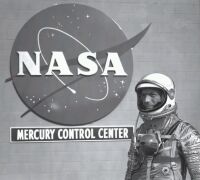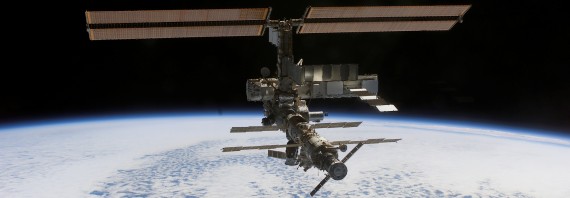|
|
| ||||||||||||||||||||||||||
|
NASA's International Space Station site has ISS news and status reports, information on US, Russian, and other nations' modules, an ISS photo, video, & interactive media gallery including a virtual reality tour, and more. The Station pages have moved to a new URL a while back, but the old pages aren't gone yet. Reference Guide to the International Space Station (2010) 140 pg .pdf Animated ISS Construction Timeline Space Station Photo & Video Gallery Current Space Station Postion Tracking ISS Evolution Data Book: Baseline Design (2000) is the real deal, a 222-page, 3.32 MB .pdf ISS Technical Configuration 1-page .pdf shows all major components of the ISS. ISS Assembly Overview a 9-page, 2.15 MB .pdf More NASA ISS Reference resources Major International Space Station Components1. Zarya, or "Functional Cargo Block" (FGB)Nov 20, 1998 launch by Russia on Proton 42,600 lbs (19,323kg), 41.2' x 13.5' (12.6m x 4.1m) - solar arrays provide 3 kW - used for storage & 16 fuel tanks (6 tons capacity) - orbital change & attitude control engines - Soyuz/Progress docking ports - US paid $220 million for Zarya see also: astronautix: Zarya 2. Node 1 or "Unity" (.pdf) Dec 4, 1998 launch by US on Endeavour STS-88 25,600 lbs, 18' x 15' (5.5m x 4.6m) - 121 electrical cables; 216 fluid & gas lines - is a connecting passageway with 6 ports:
3. Zvezda Service Module July 12, 2000 launch by Russia on Proton 42,000 lbs (19,051kg), 43' (13.1m) based on Mir core module, built for Mir 2 - took over attitude control & reboost from Zarya - 4 attitude control gyroscopes - living quarters, 13 windows, three 9", one 16" - has Data Management System from ESA - has an EVA airlock and 4 docking ports: • Zarya • Progress/Soyuz • open (Universal Docking Module) • open (Science Power Platform-- cancelled) see also: astronautix.com: Zvezda Russian Space Web: Zvezda Space.ref JSC Zvezda layout .pdfs: x - y - z Zvezda Press Kit 50 page, 1.17 MB .pdf 4. Z-1 Truss Oct 11, 2000 launch by US on Discovery STS-92 - temporary mount on Node 1 for US solar array 5. Photovoltaic Power Module (P6) Nov 30, 2000 launch by US on Endeavour STS-97 - Two 115' x 38' solar arrays, 66,000 solar cells - generates up to 64 kW of electricity 6. Destiny Lab Feb 7, 2001 launch by US on Shuttle STS-98 32,000 lbs (14,500 kg), 28' x 14' (8.5m x 4.3m) - holds up to 13 73" x 42" ISPR experiment racks - eleven additional racks hold support systems 7. CanadArm 2 Apr 19, 2001 launch by US on Endeavour STS-100 - remote manipulator arm 8. Quest Joint Airlock Feb 7, 2001 launch by US on Shuttle STS-104 13,368 lbs, 18' x 13' - can accomodate US or Russian space suits see also: SpaceRef: Quest Airlock 9. Pirs Docking Compartment (DC-1) Sep 14, 2001 launch by Russia on Soyuz 7,893 lbs (3,580 kg), 16' x 8.4' (4.91m x 2.55m) - docking for cargo vehicles, transfers propellants between Progress-Soyuz & Zvezda-Zarya - airlock for Russian Orlan spacesuits - to be replaced by Universal Docking Module 11. Mobile Base System Jun 5, 2002 launch by US on Endeavour STS-100 - mobile base for CanadArm 2 Integrated Truss Structure 10. S0 Truss Apr 8, 2002 launch by US on Atlantis STS-110 12. S1 Starboard Truss Oct 7, 2002 launch by US on Atlantis STS-112 13. P1 Port Truss Nov 23, 2002 launch by US on Endeavour STS-113 Other ISS ElementsNASA Harmony Node 2 (built by ESA) connects to Destiny, Columbus, Centrifuge Accommodation Module, Kibo, Multi-Purpose Logistics Module and H II Transfer Vehicle. It also provides a working base point for the Space Station Remote Manipulator System.European Space Agency (ESA) contributions to the ISS include the European Columbus Laboratory, and the Automated Transfer Vehicle (Jules Verne). ESA Columbus Lab ESA Node 3 will connect to Node 1, Crew Return Vehicle, Cupola, Pressurised Mating Adapter 3 and Habitation Module ESA Cupola European Robotic Arm for Russian segment ops The Japanese Experiment Module (JEM) KIBO, built by JAXA, the Japanese Aerospace Exploration Agency, was added to the ISS in 2008. JAXA was also to provide the Centrifuge Accommodation Module (CAM), but that ISS element was cancelled. ISS Logistics: Space Station Cargo CarriersESA Automated Transfer Vehicle - brochure, .pdfRussian Soyuz-based Progress M and M1 NASA Progress page Spacehab Integrated Cargo Carrier (ICC), .pdf Multi-Purpose Logistics Modules (MPLM) NASA Space Station Science Operations Major International Space Station ContractorsUS: BoeingItaly: Thales Alenia Spazio Russia: Energia Space Station ArticlesRalpha: Russian American Space Cooperation explains why the US got involved with Russian modules and crews for the ISS.Missed Deadlines is a 1998 Scientific American article by Alan Hall on late Russian deliveries of key ISS components. Other Space Station SitesSpaceRef's "Space Station Users Guide" has ISS Element Drawings.How Stuff Works: Space Stations is an easy-to-understand article by Craig Freudenrich on the ISS and its subsystems for life support, propulsion, communications, etc., very good for novices. Space Today: Space Stations Space Station HistoryEncyclopedia Astronautica presents a comprehensive historical look at the conceptual development of US Space Stations, from Wernher von Braun's doughnut, to the present ISS, with many images. Very good for connoisseurs.Russian Space Web has extensive Salyut, Almaz, Mir, and ISS information. Zarya also has Salyut, Mir, & early ISS info. |
US Commercial Crew VehicleNASA's Commercial Crew and Cargo Program Office is currently funding the development of several competing commercial spacecraft which would be used to deliver crews and supplies to and from the International Space Station. NASA's own spacecraft, the Orion MPCV, is intended for use on missions to asteroids, the Moon, and possibly Mars, although it might be used on trips to the ISS if necessary.The SpaceX Dragon is a capsule-type spacecraft which they deliver atop their own Falcon 9 launch vehicle. SpaceX has said their manned spacecraft might be ready for use by 2014. SpaceX already has a NASA Commercial Orbital Transportation Services (COTS) contract to resupply the International Space Station with a cargo-only version of Dragon. Dragon successfully completed its first ISS unmanned cargo mission in October, 2012. The Boeing CST-100 (being developed in conjuction with Bigelow Aerospace) is a capsule-type spacecraft which would utilize an Atlas V launch vehicle. The CST-100 is expected to be operational by 2015. Sierra Nevada Space Systems is developing a runway-landing spacecraft called the Dream Chaser, a lifting body based on the NASA HL-20 design. The Dream Chaser would also utilize an Atlas V launch vehicle, and is also expected to be ready by 2015. Blue Origin, funded by Amazon.com founder Jeff Bezos, is developing a Single Stage to Orbit (SSTO) vertical take off and landing type vehicle (and crew capsule) called the New Shephard, which is similar to the McDonnell DC-X Delta Clipper. However, the vehicle currently under development is strictly suborbital, and thus of limited utility. The New Shephard is expected to be operational between 2016 and 2018. ISS Commercial Resupply Services (CRS, aka COTS)In August, 2006, NASA awarded Commercial Orbital Transportation Services (COTS) contracts to two companies: $278 million to SpaceX and $207 million to Rocketplane KistlerIn February, 2008, when Rocketplane Kistler failed to secure enough financing to meet contract obligations, the remainder of their part of the COTS contract was transferred to Orbital Sciences, a company which already has proven its capabilities with dozens of payloads launched to orbit. The COTS program, the cost of which was about the same as a single Space Shuttle flight, called for the companies to demonstrate their capability to service the International Space Station (ISS) after the Space Shuttles was retired in 2011. Hawthorne, California-based Space Exploration Technologies, aka SpaceX, founded in 2002 by PayPal cofounder Elon Musk, had 400 employees as of November, 2007. SpaceX is developing their Dragon spacecraft in both manned and unmanned versions to recrew and resupply the International Space Station. SpaceX also has two launch vehicles, the Falcon 1 and the Falcon 9, both of which use LOX/kerosene burning engines. The Falcon 9 began lifting Dragon spacecraft on flights to the ISS in 2012. The 4th test of the Falcon 1, with 364lb test payload, launched from the Reagan Test Site on Omelek Island, Kwajalein Atoll, on Sep 28, 2008, was a success, becoming the first privately developed launch vehicle ever to reach orbit (500 km by 700 km, 9.2 degrees inclination, "exactly as targeted"). press Orbital Sciences has conducted over 50 space launch missions since 1990, using solid fueled vehicles. For NASA's COTS program, Orbital intends to develop the medium-lift Taurus II solid-fueled launch vehicle, and a cargo spacecraft called Cygnus, using interchangeable modules for pressurized and unpressurized cargo. The Taurus II/Cygnus combo is to deliver up to 2,300 kg of cargo to the ISS, and return 1,200 kg of cargo to Earth. Taurus II/Cygnus artists renderings Orbital's Pegasus XL, air-launched from an L-1011 aircraft at an altitude of about 40,000 feet, can carry satellites weighing up to 1,000 pounds to low earth orbit. Pegasus XL is a winged, three-stage, solid rocket booster that weighs approximately 23,130 kg (51,000 lbs), and measures 16.9 m (55.4 ft) in length and 1.27 m (50 in.) in diameter, and has a wing span of 6.7 m (22 ft). Pegasus fact sheet, .pdf Orbital has also developed a ground-launched derivative of the Pegasus, called the Taurus. The four-stage Taurus can deliver a 1,350-kilogram (3,000-pound) satellite to low-Earth orbit. Taurus fact sheet, .pdf - Taurus user guide, .pdf The Minotaur I utilizes a combination of decommissioned Minuteman II ICBM motors and Orbital's own stages and avionics. Minotaur fact sheet, 1.9MB .pdf - Minotaur user guide, 6.6MB .pdf Orbital is developing the Minotaur IV, which will use a combination of decommissioned Peacekeeper ICBM motors and Orbital's own stages and avionics. Minotaur IV fact sheet, 903KB .pdf - Minotaur IV user guide, 5.5MB .pdf NASA paid Russia's Federal Space Agency $719 million to carry 15 crew members to and from the ISS between 2009 and 2011. Additional arrangements were later made for Soyuz spacecraft to provide transport to and from the ISS until an American Space Shuttle replacement vehicle is available.
(July 17, 2005) An article in the Houston Chronicle summarized the history of the ISS, it's status, its future, and its reliance on the Space Shuttle. NASA Books (NASA Special Publications) & NASA Articles Online
NASA Books (NASA Special Publications) & NASA Articles Online
|

